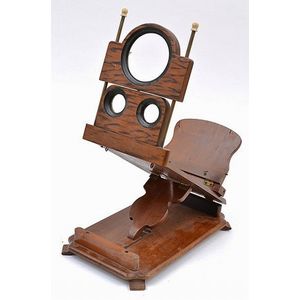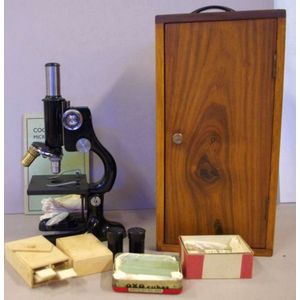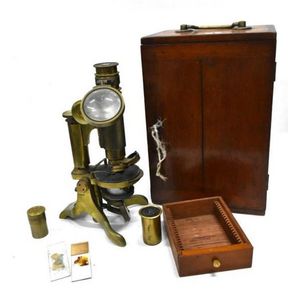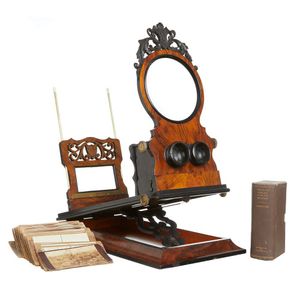Victorian Stereoscope with Collection of Stereoscopic Cards
A late Victorian walnut, ebonised and inlaid combined stereoscope/graphoscope and a collection of stereoscopic cards, with scroll carved cresting to the graphoscope lens frame and fretwork detail to the card holder, on a moulded plinth base, and a quantity of cards with scenes of the street preparations for the celebration of Federation in Sydney and Melbourne and for the visit of the Duke of York, and a boxed set 'The travel Lessons on the life of Jesus' by Forbush showing scenes in Palestine in 1900.
You must be a subscriber, and be logged in to view price and dealer details.
Subscribe Now to view actual auction price for this item
When you subscribe, you have the option of setting the currency in which to display prices to $Au, $US, $NZ or Stg.
This item has been sold, and the description, image and price are for reference purposes only.
- Victorian Period - The Victorian period of furniture and decorative arts design covers the reign of Queen Victoria from 1837 to 1901. There was not one dominant style of furniture in the Victorian period. Designers used and modified many historical styles such as Gothic, Tudor, Elizabethan, English Rococo, Neoclassical and others, although use of some styles, such as English Rococo and Gothic tended to dominate the furniture manufacture of the period.
The Victorian period was preceded by the Regency and William IV periods, and followed by the Edwardian period, named for Edward VII (1841 ? 1910) who was King of the United Kingdom and the British Dominions and Emperor of India for the brief period from 1901 until his death in 1910. - Federation Period - The Federation style in architecture and furniture is broadly the Australian equivalent of the English Edwardian period and extended from 1890 to 1915. The name relates to Australia becoming a Federation in 1901, when the colonies became the Commonwealth of Australia.
This item has been included into following indexes:
Visually similar items

Victorian foldable stereoscope viewer walnut table top viewer with two ivory finials, central magnifier missing
Sold by
in
for
You can display prices in $Au, $US, $NZ or Stg.

Crown Lynn, pair Wharetana Ware bookends, brown glaze impressed no, 1020 (factory flaws and repaired damage to one)
Sold by
in
for
You can display prices in $Au, $US, $NZ or Stg.

Bausch & Lomb USA microscope, with box & accessories, model AB1794
Sold by
in
for
You can display prices in $Au, $US, $NZ or Stg.

A Victorian mahogany brass microscope, retailed by Clarksons London, with slides, lens & instruction manual
Sold by
in
for
You can display prices in $Au, $US, $NZ or Stg.
